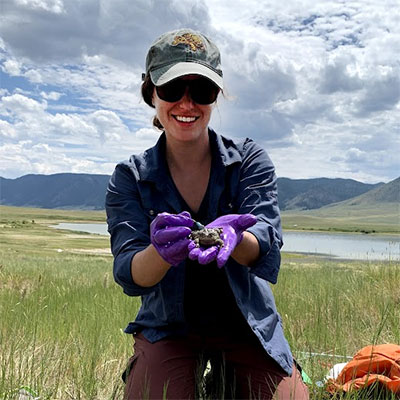Rachel Arrick - Linking microbial biodiversity to chytridiomycosis resilience: can bacteria aid in the conservation and recovery of the critically endangered Wyoming toad (Anaxyrus baxteri)?
Rachel Arrick
Biodiversity Graduate Student Research Enhancement Grant Awardee
Ecosystem Science and Management Department
Advisor: Melanie Murphy

Project Objectives:
My research will direct the development of microbiome-based conservation strategies (e.g., probiotics and habitat manipulation) for amphibians impacted bychytridiomycosis. Using the Wyoming toad as a focal species, I will (A) determine the relationship between cutaneous microbial diversity and chytridiomycosis outcome, (B) identify microbial biodiversity linked to chytridiomycosis resilience in the wild, (C) note putatively Bd-inhibitory bacteria missing from captivity, and (D) documentbiotic and abiotic factors associated with a beneficial microbiome.
Background and Rationale:
Considered the most threatened vertebrate taxa globally, amphibians have experienced severe declines in both abundance and range in recent decades, largely due to the synergistic effects of infectious disease and habitat degradation. Chytridiomycosis (hereafter “chytrid”) is an
amphibian disease caused by the fungal pathogen, Batrachochytrium dendrobatidis (Bd). Chytrid has been linked to the extinction of at least 90 species and the and decline of over 500 worldwide, which is the largest estimated loss of biodiversity attributed to a single pathogen to date. Unfortunately, no practical method to treat or eliminate chytrid in the wild exists. In response,many highly susceptible species were transferred to captive assurance populations to counter extinction,with the ultimate goal of repatriation.However, recovery efforts for these species remains challenging as Bd has become endemic in many native habitats. The microbiome, or symbiont microbes (i.e., bacteria) present on amphibian skin, offer innate protection against Bd and could be manipulated via probiotic application or habitat manipulation to improve chytrid mitigation for captive release programs.
Share This Page

Research Highlights




